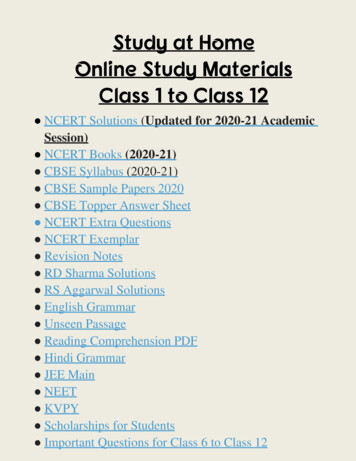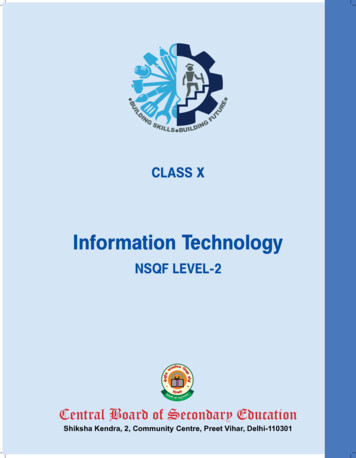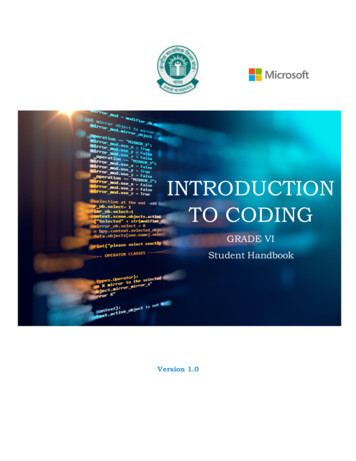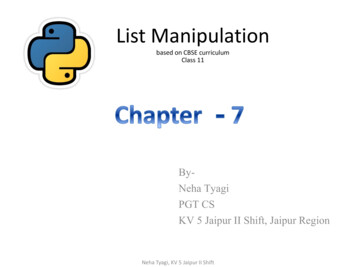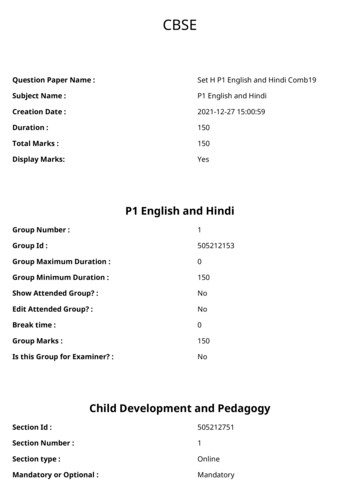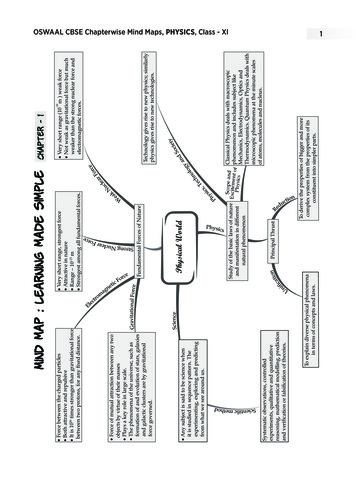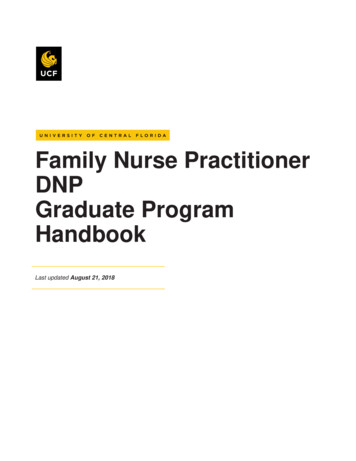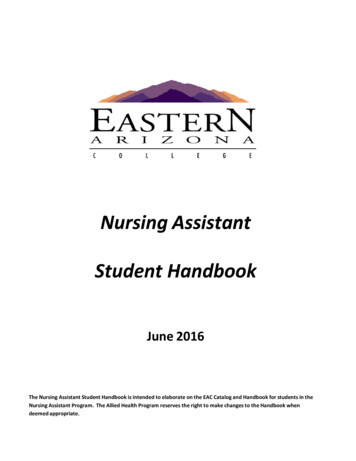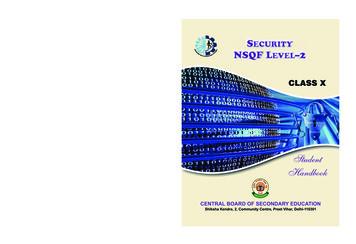
Transcription
Class XStudent HandbookCENTRAL BOARD OF SECONDARY EDUCATIONShiksha Kendra, 2, Community Centre, Preet Vihar, Delhi-110301
Security, NSQF Level–2Student Handbook, Class XPrice : First Edition : April 2016, CBSECopies :Paper Used: 80Gsm CBSE Water Mark White Maplitho“This book or part thereof may not be reproduced byany person or agency in any manner.Published by:The Secretary, Central Board of Secondary Education,Shiksha Kendra, 2 Community Centre, Preet Vihar,Delhi - 110301Design & Layout by:India Offset Press, A-1, Mayapuri Industrial Area, Phase-I,New Delhi-110064www.indiaoffsetpress.comPrinted by:M/s.
PrefaceThe Student Handbook on Security for level 2 (class X) is a part of the QualificationPackage developed by the Security Sector Skill Development Council (SSSDC)under National Skill Qualification Framework (NSQF) for unarmed securityguard (private security sector). The NSQF is an initiative of the Government of India toset common principles and guidelines for a nationally recognized qualification systemcovering schools, vocational education and training institutions, technical educationinstitutions, colleges and universities. It is envisaged that the NSQF will promotetransparency of qualifications, cross sectoral learning, student centered learning andfascinate learner’s mobility between different qualifications, thus encouraging life longlearning.The Private Security Sector (PSS) industry comprises those agencies or people, whoprovide security for people and property. An unarmed security guard is required toobserve, deter, record and report.The National security agencies i.e., the army, the navy, the air force, the police andsecret intelligence organizations are responsible for providing security to the citizens ofthe nation. At the local level, private “Security Firms” provide protection to human bodyand property of corporate, household and individual through the provision of “securitysystems”, which include burglar alarms, electronic surveillance and personal securityguards, etc., who work in the areas of asset protection, transport services, eventsservices as well as personal protection and the protection of valuable objects in theprivate and public spheres.To achieve these objectives, Central Board of Secondary Education has started avocational course in Security. After necessary knowledge in security, the students willhave an edge over others in getting jobs in this sector.This book is authored by professionals in the field of security under supervision ofPSSCIVE with a focus on real word of security in an interesting and lucid manner.Any suggestions/feedback are welcome for further improvement of the book.Chairman, CBSEv
AcknowledgementsAdvisors1.Sh. Y. S. K. Seshu Kumar, Chairman, CBSE2.Sh. K. K. Choudhury, Controller of Examinations & Director (V.E.), CBSE3.Prof. R. B. Shivagunde, Joint Director, PSS Central Institute of VocationalEducation, BhopalMaterial Developed by1.Prof. Vinay Swarup Mehrotra, Professor & Head, PSS Central Institute ofVocational Education, Bhopal2.Col. (Retd.) Tapesh Chandra Sen, Dy. Director (ACD), Security Sector SkillDevelopment Council (SSSDC), Gurgaon3.Ms. Leena Kapoor, Unifiers Social Ventures Pvt. Ltd., New Delhi4.Mr. Mohit Sharma, International College for Security Studies, New Delhi5.Maj. (Retd.) Bikram Singh, New Delhi6.Lt. Col. (Retd.) Pradeep Bajaj, Noida7.Lt. Col. (Retd.) Neeraj Gupta, Noida8.Mr. Girwar Singh Narooka, General Navy Trainer, Alwar, Rajasthan9.Major General (Retd.) B.S. Ghotra, Chief Operations Officer, Security SectorSkill Development Council (SSSDC), GurgaonContent Review1.Colonel Utkarsh Singh Rathore (Retd.), Security Sector Skill DevelopmentCouncil, GurgaonEditing & Coordination1.viDr. Biswajit Saha, Additional Director (V.E.), CBSE
IndexUnit 1 :Basic Drill and Defensive Techniques1Introduction2Session 1: Performing Drill3Session 2: Personal Hygiene and Grooming11Session 3: Identifying Vulnerable Parts of the Human Body15Session 4: Performing Basic Self-defence Techniques19Unit 2:26Disaster Management and Emergency Response (Advanced)Introduction27Session 1: Disaster Management and Emergency Response28Session 2: Role and Responsibilities of Emergency Response Team36Session 3: Fighting Fire45Unit 3:62Security Structure and Laws Governing Private SecurityIntroduction63Session 1: Security Structure in India64Session 2: The Armed Forces69Session 3: Para Military Forces79Session 4: Central Armed Police Forces84Session 5: State Police Forces89Session 6: Private Security Industry93Session 7: Laws Governing Security Services97Unit 4:Introduction to Information Technology102Introduction103Session 1: Basics of Information Technology104Session 2: Working on Computer System120Session 3: Managing Files and Folders128vii
Unit 5:Email Messaging134Introduction135Session 1: Opening Email Account, Composing Mail and Attaching Files136Session 2: Sending, Forwarding, and Searching Email147Session 3: Organising Emails and Managing Contacts153Session 4: Email Etiquettes and Best Practices161Unit 6:168First Aid Practices (Advanced)Introduction169Session 1: Basic First Aid170Session 2: Methods of Evacuation and Rescue176Session 3: Common Knots Used in Evacuation182Session 4: Identifying Parts of Human Body187Session 5: Administering Cardio Pulmonary Resuscitation193Unit 7:202Work Integrated Learning – Security Services – L2Introduction203Session 1: Structure and Functions of Private Security in India204Session 2: Legislation and Rules Governing Private Security in India213Session 3: Security Equipment217Session 4: Searching and Documentation224Session 5: Role and Functions of Private Security Personnel228viii
Unit–1Basic Drill andDefensive Techniques1
Unit - 1IntroductionHave you seen the 26 JanuaryRepublic Day Prade? Most of us havewatched it on the television. Someof you must have had the privilegeof witnessing it live at the Rajpath inNew Delhi.Marching Contigents of armed forces,central armed police forces andmilitary bands; display of defenceequipment and colourful tableausfrom the States are the hallmark ofthe parade.Do you know that preparations for theRepublic Day parade start monthsin advance? Movement of each contingent is rehearsed and timed and the troopsparticipating in the parade practice their drill movements tirelessly to achieve perfection.What is drill? Drill simplifies complex movements in to simple steps, for the ease oflearning and performance. Drill is not restricted to a parade alone; it is also used forsimplifying complex movements such as equipment and weapon handling.You must have heard about ‘Self-defence’. Your parents want you to learn it; thepolice organises self-defence training camps regularly. What is self-defence? Why is itnecessary?There is violence and crime in oursociety. Everyone feels vulnerable.Self-defence enables us to defendourselves and others from the acts ofcriminals and anti-social elements.Self-defence techniques are martialart forms, which do not use weaponsor firearms. It is also known as‘Unarmed Combat’. There are manyforms of unarmed combat such as;judo, karate, kung-fu, taekwondo, etc.Through this Unit, you will learn aboutthe basic drill movements and selfdefence techniques.2
Security Level-2Unit - 1Session–1Performing DrillRelevant KnowledgeThe term drill comes from the old tradition ofbattle, in which soldiers battle, stood together ina certain formation to face an enemy. Drill is theprocess of memorising and performing certainactions through repetition until the action isinstinctive to the personnel performing it.Drill is a form of physical activity carried out byan individual or a group, which imbibes disciplineand smartness. It is practiced several times forperfection. This activity is mainly carried out bythe Army, Police, Firefighters, cadets, etc. todemonstrate discipline, team work, authority and uniformity. There are no individualsin a team; everyone performs the movement at the same time and in exactly the sameway. Complex actions are broken down into simpler ones which can be practiced in smallgroups so that when the whole act is put together and the desired results are achieved.Aim of DrillThe aim of drill is to transform a trainee into an obedient, alert and smart soldier.The main purpose of formal parade ground drill is to enable trainees to move easilyand quickly from point to point in an orderly manner. Drill in battle ensures thateveryone does what they have been trained to do, irrespective of noise and otherdistractions.The benefits of drills include the following:1. It allows the team to respond quickly and effectively to a situation or anemergency.2. It helps an individual or group to be familiar with the standard procedures andoperate an equipment or weapon effectively.3.It helps in developing self confidence and perfection in performing variousactivities.3
Unit - 1Military ParadeDrill in military terms is the process of memorising certain actions through repetition untilthese become instinctive to the soldiers individually. Complex actions are broken downinto simpler ones which can be practised. When the whole act is put together desiredresults are achieved. Drill is necessary for any team to perform at maximum efficiencyin all situations.Military parade is a formation of soldiers whose movement are controlled by word ofcommand. A military ceremony is organised for the following purposes:1.Honouring a visiting high-ranking commander, official, or dignitary;2.Presenting decorations and awards;3.Honouring or recognising an unit’s or individual’s achievements; and4. Commemorating events.Only one person is in charge of a parade. He/she is known as the parade commander,who command entire parade.The following rules for giving commands apply a commander :1.When at the halt, the commander faces the troops for giving commands; and2.When marching, the commander turns head in the direction of the troops to givecommands.Parade consists of four directions:1.Advance: It is the primary direction of movement, regardless of which direction thesoldiers are actually facing.2.Retire: It is opposite of the Advance.3.Left: It is to the left of the Advance.4.Right: It is to the right of the Advance.The typical parade commands are spoken extremely clearly and emphatically, andconsist of four major parts, namely the identifier, the precautionary, the cautionaryand the executive as under :1.Identifier is the one or group who is to follow the command. This is typically(number) Section, (number) Platoon, (letter) Company, or (name) Regiment.2.Precautionary or what is to be done. For example, move to the advance, move toretire, etc.3.Cautionary or the first part of what is to be done. It is usually drawn out to twosyllables. For example, for a right wheel: “right turn”, “right” is the cautionary.4
Security Level-2Executive is a single syllable on which the soldiers actually move. There is alwaysa significant pause between the cautionary and the executive. The executivecommand should always be given a greater emphasis and be as loud possible.In private security, security personnel are taught basic drill movements to imbibediscipline, correct their posture and to work in a team. Thus, the importance of drill inprivate security is to develop obedience, smartness and team spirit amongst securitypersonnel.4.Drill commands are generally used for a group that is marching.Marching, also called as Marchpast, refers to the organised, uniformed, steady andrhythmic walking. While marching, individuals must maintain their dress, cover, interval,and distance.1.Dress—Alignment with the person to the side.2.Cover—Alignment with the person in front.3.Interval—Space between the person(s) to the side.4.Distance —Space between the person in front.During the British rule, the Indian Armed Forces used the English drill commands. Afterthe Independence, Indian Armed Forces and other uniformed forces in the country useHindi ‘Word of Commands’.Some of the state police units, however, still continue to use English drill commands. Thecommon drill commands for drill without arms used byvarious uniformed organisations in India are as follows:1.Savdhan - Attention (lko/kku): The position ofattention is the basic drill position. It indicates thatan individual or group is alert and ready to receiveinstruction. On the command Savdhan, one hasto stand with heels together, feet forming an angleof 30 degrees, head and body erect, hips andshoulders level, and chest lifted. Allow your armsto hang naturally—thumbs along skirt or trouserseams and fingers joined and in their natural curl.Keep your legs straight, but not stiff at the knees.Direct your head and eyes to the front. Keep yourmouth closed, and pull your chin in slightly.FRONT VIEWSIDE VIEWAttention5Unit - 1Drill Commands
Vishram - Stand-at-ease (foJke): On the commandvishram, one can relax and shift about, but keep theright foot in place. Left foot is moved to shoulderwidth and the hands are placed behind the backwith arms fully extended. The right hand is placedinside the left with all fingers together and pointingrigidly downwards. One must not talk, but mayremain relaxed.3.Line Ban - Fall in (ykbu cu): Resume your placein ranks, and come to attention.4.Line Tod - Fall out (ykbu rksM ): This is done with20 cm20 cma right turn followed by either three steps or aQuick March in a straight line to the edge of theStand at-easeparade square.Hilo Matt - Stand Still (fgyks er): This command is given to a group, which isalready in attention.Aaram Se - Stand easy (vkjke ls): Legs remain at ease position, arms are broughtto the sides to a more natural standing position. Make minimal movements and youshould not talk or shift from the current place.Sajj Dahine Sajj - Dress Right Dress (lt&nkfgus lt): On this command allmembers in the unit except the right marker take two steps forward, pause, andbring up their arms parallel to the ground and at the same time snap their heads sothey are facing right, unless otherwise specified(elbow dressing or shoulder dressing). Afterthis, they pause, and then shuffle back to a newposition, where their hand is extremely close tothe member‘s shoulder on their right. The onlything that should change is the position of thehead. They should turn their head to the right ata 45º angle. They should then line themselvesup with the person to their immediate right.Sajj Bayen Sajj - Dress Left Dress (lt&ck;sa lt): It is same like as Right Dressbut to the left. They have to adjust themselves until they are in line with the personto their left.Dahine Mud - Right Turn (nkfgus eqM ): A 90 turn to the right is done by turing onthe heel of the right foot and toes of the left foot. Left leg is then stamped down onthe ground.Unit - 12.5.6.7.8.9.6
Security Level-215. Kooch Kar - Take Charge (dwp dj): Usually given when a senior officer wantssomeone junior to him/ her to take charge of the parade/ company/ troop. Onhearing this command, the junior officer would take a step forward, salute and thentake about turn to face the men on parade.17. Parade Par - On Parade (ijsM ij): Usually given during parades, when certainofficers who would be standing as a separate group, are required to march up tostand in front of the troops coming under them.18. Visarjan - Dismiss (foltZu): A fall-out where the soldiers have free time until theirnext designated work period.19. Dahine Dekh - Eyes Right (nkfgus ns[k): On this command marchers, turn theirheads and eyes 45 degrees to the right. To return their heads and eyes to the front,the command (lkeus ns[k) is given as the left foot strikes the ground.20. Saamne Dekh - Eyes front (lkeusare turned smartly to the front.ns[k): On the command front, heads and eyesCharacteristics of a Good DrillA good drill should include a proper physical exercise programme, a motivationalprogramme and a record-keeping exercise. The characteristics of a good drill includethe following:7Unit - 110. Bayen Mud - Left Turn (ck;sa eqM ): A 90 turn to the left is done by turning on theheel of the left foot and toes of the right foot. Right leg to then stamped down onthe ground.11. Tham - Halt (Fke): On this command a marching individual or contingent comesto a halt.12. Tez Chal - Quick March (rst py): On this command an individual or a contingentcommences marching. The standard pace of marching is 120 steps per minute.13. Dheere Chal - Slow March (/khjs py): This is a ceremonial pace used for funeralmarches or when a unit’s colors are marched out in front of the troops. The standardpace is 60 paces per minute.14. Daud ke Chal - Super Quick Time (nkSM ds py): This is essentially a moderate jogat approximately 180 paces per minute. It creates a travel speed of approximatelydouble that of Quick Time, normally used for warming up the trainees before thedrill.15. Parade Teeno-teen main Dahine/Bayen Chalega - Move to the right/left incolumns of threes (ijsM rhuksa&rhu esa nkfgus@ck;sa pysxk): This command is givenjust before the orders to actually execute the right or left turn.
Physical Fitness: Physical fitness has been defined as a set of attributes orcharacteristics that people have or achieve that relates to the ability to performphysical activity. It comprises two related concepts: (i) general fitness (a state ofhealth and well-being), and (ii) specific fitness (a task-oriented definition based onthe ability to perform specific aspects of sports or occupations). Physical fitnessis generally achieved through correct nutrition, exercise, and rest. Therefore, atraining programme includes exercise, rest and relaxation.Unit - 1(i)Correct posture of standing and walking is very important in drill and for militarybearing. In standing position, both the heels of the feet should meet each other.Toes of the feet should be 3 to 4 inches apart. The whole body should be erect,straight, knees and chin inside, chest forward, and belly backward and pressedinside with equal body weight on both feet. While walking, the heel of the footshould touch the ground and then weight should be transferred to the toes, whichmeans that there should be heel- toe action and the marching should be smoothand graceful with chest out.(ii)(iii)(iii)8Word of Command: Good drill depends in the first instance on good words ofcommand. A word of command to a squad of six men need not be as loud as acommand to a large body of troops.Words of command must be given at all times with precision. Instructors, whengiving words of command, must stand to attention and should not move along withthe squad.Motivation: Motivation means to be inspired to do something. There are twotypes of motivational forces that drive a person to perform activities: (i) Intrinsicmotivation: It comes from within oneself, and (ii) Extrinsic motivation: It occurswhen external factors compel a person to perform something. For example, rewardsand awards act as extrinsic factors. Motivation arises from the learners’ interestand expressed purposes. It is necessary to arouse the learners’ sustained effort inthe learning activity. Briefing of the participants of the drill is done for not only tellingthem of the various aspects of the drill, but also motivating them.Record-Keeping: Drill is also used to simplify and rehearse a complex procedure,such as emergency evacuation from a premises. A good drill will make everyindividual understand his / her role and responsibility in the whole process. Properrecord of such drills / rehearsals are maintained, which include the followinginformation:1. Identity of the person conducting the drill2. Date and time of the drill3. Notification method used
Security Level-2Staff members on duty and participatingNumber of occupants evacuatedSpecial conditions simulatedProblems encounteredWeather conditionsTime required to accomplish complete evacuationUnit - 14.5.6.7.8.9.EXERCISEPractice SessionPractice the movements using the following commands under the supervision of yourteacher or trainer:1.2.3.4.5.6.7.8.9.10.11.12.Line Ban – Fall inLine Tod – Fall outSavdhan – AttentionHilo Mat – Stand still or Don‘t moveVishram – Stand-at-easeDahine Mud – Right turnBayen Mud - Left turnTham – HaltDahine Dekh – Eyes rightBayen Dekh – Eyes leftSaamne Dekh – Eyes frontVisarjan – DismissASSESSMENTFill in the Blanks1.A is the process of memorising and performing certain actionsthrough repetition until the action is instinctive to the personnel performing the drill.2.Drill teaches d and t work.3.Drill allows a team to respond v and e in a situation oran emergency.9
Unit - 14.is the one or group who is to follow the command.5.is the command which implies what is to be done.6.is the single syllable on which the soldiers lya ,r , l , and r .8. In Mat, no body movement is allowed but participants of the marchpastare free to talk among themselves.9.While marching individuals must maintain their , cover,and distance.10. On the command Savdhan, you are alert and ready for .11.On the command Vishram, you may remain relaxed but you should nott .12. If a senior officer wants someone junior to him/ her to take charge of the parade,then he/ she will give command Kar.13. The two types of motivation are and .CHECKLIST FOR ASSESSMENT ACTIVITYUse the following checklist to see if you have met all the requirements for assessmentactivity.Part A(a)Differentiated between different drill commands.Part BDiscussed the following in the class:(a)(b)(c)10What is the need and importance of drill?What are the characteristics of good drill command?What are the different types of motivation?
Security Level-2Part CUnit - 1Performance StandardsThe performance standards may include, but not limited to:Performance StandardsYesNoDemonstrate the movements on the following commands:1. Line Ban2. Line Tod3. Savdhan4. Vishram5. Dahine Mud6. Bayen MudSession–2Personal Hygiene and GroomingRelevant KnowledgeGrooming means the act of making oneself neat and tidy, itincludes personal hygiene. Personal grooming is an integralpart of any uniformed profession. A well groomed securityprofessional commands respect for himself / herself and his/her organisation. Correct wearing of uniform and proper turnoutdistinguishes security personnel from the general public.Security personnel must always be properly groomed anddress up smartly, only then they will be able to create a goodimpression on others and earn respect. Well groomed securitypersonnel is always taken seriously while an untidy andimproperly dressed one is ignored by the visitors.11
Unit - 1Personal HygienePersonal hygiene is the first step to good healthand grooming. Personal hygiene practicesinclude regular washing/ bathing, healthy eatinghabit and seeing a doctor or dentist whenrequired.Body hygiene pertains to hygiene practicesperformed by an individual to care for one’s bodilyhealth and well being. Motivations for personalhygiene practice include reduction of personalillness, healing from illness, optimal health andsense of well being, social acceptance andprevention of spread of disease to others.Good HabitsGood habits such as taking regular exercise, staying away from smoking, alcohol anddrugs and taking precautions with regards to sexually transmitted diseases must be apart of all security personnel.Essentials of UniformA “uniform” is any distinctive clothing intended toidentify the individual wearing it as a member ofa specific group or an organisation. Uniform, asthe name suggests gives uniformity and a senseof equality to a select group of people carryingout a particular duty or task. At the same time, itdifferentiates the personnel from general public.As the uniform gives responsibility and authority,it is the duty of security personnel to maintain his/her uniform.It is mandatory for the security personnel to wear a distinct the uniform. The colour of theirdress should be different from those of army and police personnel. The following pointsare to be kept in mind while wearing the security uniform. Private security companiesmust ensure that their employees wear uniforms on duty at all times. Such uniform mustbear the logo of the company. They must also ensure that their colours and styles do not12
Security Level-2vWorn only during duty hours;vKept neat, clean and properly ironed;vWorn only when complete set is available;vWorn as per the prevailing season.Besides the uniform, a security personnel should also wear (i) An arm badge distinguishingthe agency; (ii) Shoulder or chest badge to indicate his position in the organisation;(iii) Whistle attached to the whistle cord and to be kept in the left pocket; (iv) Shoes witheyelet and laces; and (v) A headgear which may also carry the distinguishing mark ofthe agency.Identity CardEvery private security agency must provide identity cards to itspersonnel. An identity card bears the name and employee numberof the holder of the card and the name and license number of theagency, along with the photo of employee in colour.Other details on the identity card should include:vPosition of the card holder in the company.vDate of issue and expiry of the card.vDetails of the issuing authority.vStamp of the company.Identity card should be returned to the issuing agency, once the private security guard isno longer engaged or employed by it. Any loss or theft of identity card will be immediatelybrought to the notice of the agency that issued it. Every private security guard while onactive security duty will wear and display photo-identity card issued under Section 17 ofthe PSAR Act.EXERCISEGiven below is the self-checklist for personal hygiene. Tick the practices that you alreadyfollow and try to practice other personal hygiene and health practices. If you face anyproblem, discuss with your parents and teachers.13Unit - 1conflict with other private security companies operating in the country or with those ofthe army and police. The uniform should be:
Unit - 1Personal Hygiene PracticesYes I doKeep nails clipped and clean.Use soap and shampoo regularly.Avoid stepping out of the house withouta bath.Eat breakfast after taking bath.Wear clean and ironed clothes.Wash hands with soap before and aftereating.Brush teeth regularly.Keep house and surroundings clean.Comb hair at intervals to avoid appearingtired and messed up.Keep hair trimmed and clean.Wash hands after using the toilet oranything that is not clean.Cover face with a handkerchief whilesneezing or coughing.ASSESSMENTFill in the blanks1.Grooming means the act of making oneself n and tidy.2.Personal h is the first step to good grooming and goodh .3.Personal grooming include personal h , as it pertains to themaintenance of a good personal and public appearance.4.A u is any distinctive clothing intended to identify the individualwearing it as a member of a group or organisation.14
Security Level-2CHECKLIST FOR ASSESSMENT ACTIVITYPart A(a)Differentiated between personal hygiene and grooming.Part BDiscussed the following in the class:Actions required to be taken to keep the following body parts hygienic and healthy: nails,eyes, hairs, teeth, hands, and feet.Part CPerformance StandardsThe performance standards may include, but not limited to:Performance StandardsYesNoDemonstrate good personal hygiene practices.Explain requirement of uniform and identity card for securitypersonnelSession–3Identifying Vulnerable Parts of the Human BodyRelevant KnowledgeWe all assess threats to our life and property and take necessary precautions. Forexample, we avoid dark streets and alleys at night to save ourselves from assailant andother dangers. We lock doors to protect property from thieves. We learn martial artsand self-defence techniques to protect ourselves from others who may want to harm us.Common security risks that a security guard has to address are trespassing, unauthorisedaccess, disorderly and disruptive behaviour, theft, burglary, robbery, assault, loss of15Unit - 1Use the following checklist to see if you have met all the requirements for assessmentactivity.
Unit - 1information and damage to property. Being physically fit and well-trained in self defencetechniques will help you in facing such threats.Threats are everywhere you might have seen that a shopping mall has security guards atthe entrance, exits and other locations. The restaurants have their own security guardsover and above to those employed by the shopping mall management. In case of anunruly or violent behaviour of a visitor, the security guard is required to take necessarysteps to prevent harm to self or the general public. He or she should be able to control thetroublemaker by applying some force. To achieve this, a guard should have a thoroughknowledge of the vulnerable parts of human body. It helps us to strengthen and protectour vulnerable body parts from an attacker and respond suitably to the opponent in caseof an assault.In this session we will identify the vulnerable parts of human body. For better understandingwe should know about the vital parts of the body.Vulnerable Parts of Human the BodyYou should always wear the personal protective equipment such as headgear, elbowguard, mouth guard, etc. to protect yourself from injury while practicing self defencetechniques. There are some vital points in human body. A focused attack on anyone ofthem will cause an immediate harm and injury to the opponent. Therefore, it is importantto understand how a particular body part would be affected in case of injury.Base of the Skull: If there is trauma to the head,Clavicleheadache, disorientation or unconsciousness Scapulacan occur. Sometimes, due to head trauma bra
Security, NSQF Level-2 Student Handbook, Class X Price : First edition : April 2016, cBSe copies : Paper Used: 80Gsm cBSe Water Mark White Maplitho "This book or part thereof may not be reproduced by any person or agency in any manner. PUBLISHED BY: The Secretary, central Board of Secondary education,
